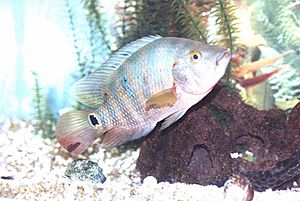Mayan cichlid facts for kids
Quick facts for kids Mayan cichlid |
|
|---|---|
 |
|
| Conservation status | |
| Scientific classification | |
| Synonyms | |
|
The Mayan cichlid (scientific name: Mayaheros urophthalmus) is a type of fish called a cichlid. It's also known as the Mexican mojarra. This fish is quite interesting because it can live in many different kinds of water.
Contents
Where It Lives
The Mayan cichlid lives in Middle America. It is naturally found on the Atlantic side of tropical Mesoamerica. Its home range stretches from eastern Mexico all the way south to Nicaragua.
This fish has also been found in new places. It was first seen in Everglades National Park, Florida, in 1983. Now, it is a common fish in South Florida, even though it's not originally from there.
Its Home Environment
The Mayan cichlid can live in many different places. You can find it in freshwater marshes, mangrove swamps, lakes, rivers, and rocky shorelines. It also lives in lagoons, estuaries, and near coastal islands.
Adult Mayan cichlids often prefer coastal lagoons and rivers. They can even survive in salty ocean water! These fish like areas with lots of oxygen, especially near underwater plants or over muddy ground.
Even though they prefer oxygen-rich water, they are very tough. They can survive in water with very little oxygen for a short time. This is because they become much less active when oxygen is low. They can even survive almost no oxygen for up to two hours. This fish has also been found in some special underwater caves called cenotes in the Yucatan Peninsula.
What It Looks Like
The Mayaheros urophthalmus can grow quite large, up to about 39.4 centimeters (about 15.5 inches) long. It is one of the bigger cichlid fish. Its body is oval-shaped and flat on the sides. Its head gets narrower towards its mouth. The fins of this fish are spiny.
Most Mayan cichlids have a base color of yellow-brown to gray-brown. But when they are ready to breed, their color changes to a bright red! The head and throat are often reddish, especially in younger fish. The tail fin and the soft parts of the top and bottom fins are usually reddish too.
This fish has six wide, green-black stripes that run vertically across its sides. These stripes go from behind its front fin to its tail fin. It also has a large black spot on its tail stem, which is circled with blue-green. This "eye spot" on the tail is why its scientific name is urophthalmus (oura means tail and ophthalmos means eye in Greek). Since these fish live in a large area, their colors can sometimes be different from what is described here.
Why It's Important to People
In the places where it naturally lives, the Mayan cichlid is a popular fish to eat. Because of this, it supports local fishing and is often raised in fish farms, which is called aquaculture.
Wild Mayan cichlids often have brighter red colors than those raised in tanks. You can help tank-raised fish keep some of their bright color by feeding them live food. Foods that contain Vitamin A also help, as Vitamin A turns into a red pigment called beta-carotene in their bodies.
This fish is one of the most studied Neotropical cichlids. Most of the research on the Mayan cichlid has happened in southeastern Mexico, especially on or near the Yucatan Peninsula.
Biology
The Mayan cichlid tends to stay in one place. This means individuals usually do not migrate and prefer to remain within their home area.
The Mayan cichlid needs water temperatures of at least 14 degrees Celsius. In its natural habitat, it lives in water that is 18 to 34 degrees Celsius. However, its favorite temperature range is 28 to 33 degrees Celsius.
This fish is very adaptable. It can live in water with different salt levels, from fresh water to very salty water (0 to 40 ppt). Studies have shown it can handle sudden increases in saltiness. The Mayan cichlid can also eat many different kinds of food. Its jaw can stick out quite a bit, which helps it catch fast-moving prey.
The Mayan cichlid eats a wide variety of things. Its diet includes plants, smaller fish, algae, dead organic matter (detritus), snails, crustaceans, and insects. However, it needs a good amount of animal prey in its diet to stay healthy.
Reproduction and Life Cycle
When Mayan cichlids are breeding, they become very territorial and aggressive. They are very protective parents and will guard their young. They can have several groups of babies each year.
This species forms pairs and both parents take care of the eggs and young. The male and female look very similar. They lay their eggs on a surface, like a rock. They guard their baby fish (called fry) for up to six weeks. These parenting traits are very strong in the Mayan cichlid.
In Mexico, Mayan cichlids lay eggs for about nine months, from March to November. They are especially active during the wet season, from June to September. This happens when the water temperature is at least 24 degrees Celsius. They raise multiple groups of young each year.
The baby fish seem to be made for moving water. When they hatch, they actively swim down to the bottom. They stick themselves to the ground using special sticky glands.



